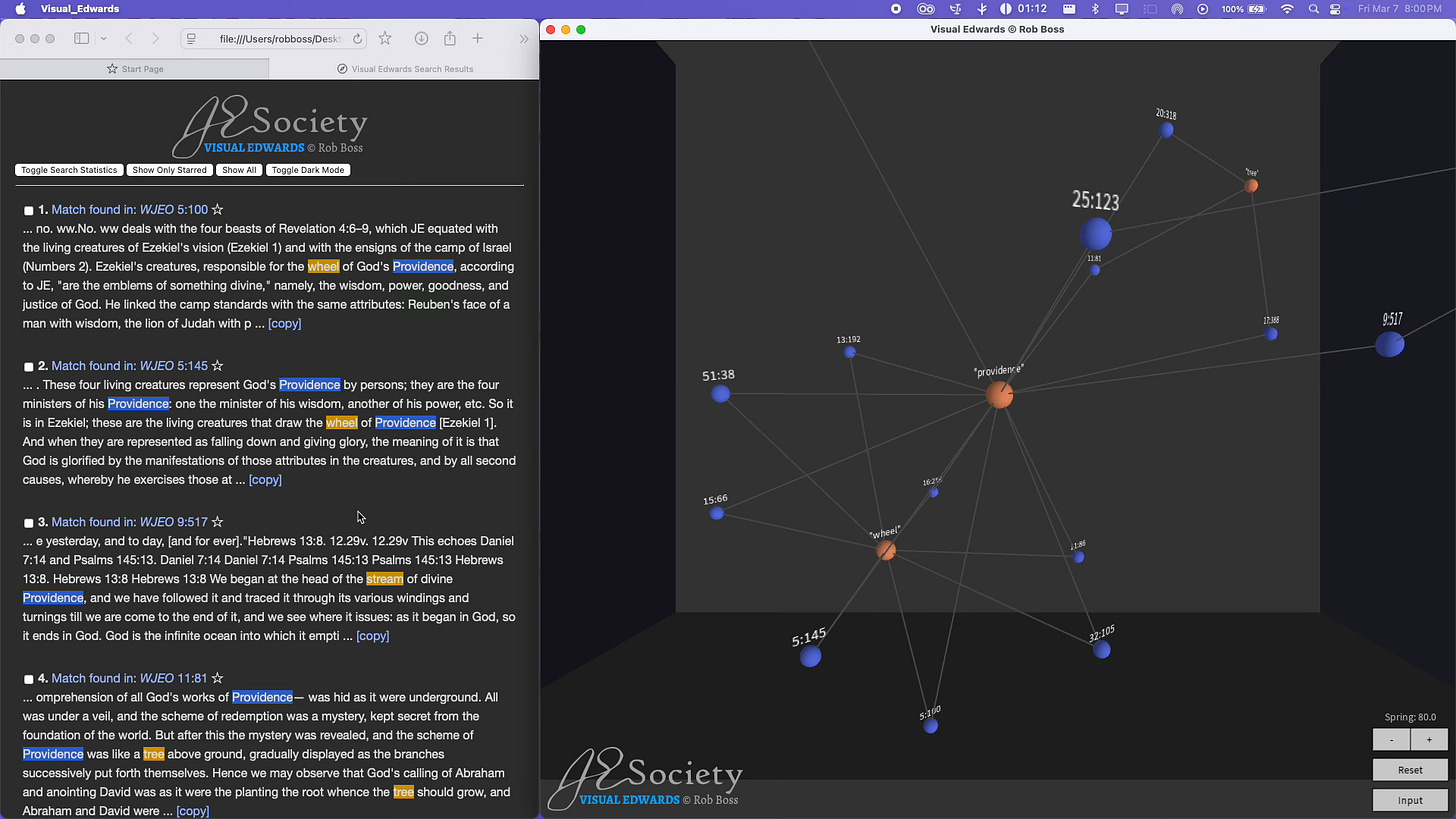Much progress has been made since I first presented the Visual Edwards project at three Jonathan Edwards conferences in 2019 (Gateway Seminary, Yale, and Budapest). Much of what I presented at that time was proposals and projections. The project has matured much since I was interviewed by Joey Cochran for JECTEDS Edwardseana in 2017. It is still a vision in the works. Below is a screencast along with a brief description of Visual Edwards in its current state:
Description
Visual Edwards is a cutting-edge program that transforms the study of Jonathan Edwards’ writings, offering a deeply immersive and analytical approach to his texts. This innovative tool is crafted to analyze and visualize Edwards’ extensive 73-volume corpus, shedding new light on the intellectual breadth and theological depth inherent within his works.
Core Features and Benefits
1. Comprehensive Textual Analysis: At the heart of Visual Edwards is its sophisticated text search capability. Users can input multiple search terms/phrases and define specific parameters such as maximum word distances and context length, allowing for a nuanced exploration of Edwards’ discourse. This adaptability ensures initial findings are both rigorous and aligned with academic standards, making it a vital tool for detailed textual analysis.
2. User-Friendly Interface: The interface is designed with accessibility in mind, providing an array of toggles and controls that cater to both beginner and advanced users. By streamlining the search process, Visual Edwards encourages users to effortlessly set parameters and engage with the text, facilitating a deeper understanding of Edwards’ arguments and themes.
3. 3D Graph Visualization: One of the most striking features of Visual Edwards is its dynamic, 3D force-directed graph visualization. This feature transforms abstract text into visual networks, revealing the interconnected ideas and concepts within Edwards’ writings. Such visual representation enhances cognitive processing, allowing users to discern patterns and relationships that might otherwise remain obscured in textual form.
4. Interactive Exploration: Visual Edwards invites users to actively engage with their data. The interactive graph supports panning, rotating, and zooming, allowing scholars to closely examine specific areas of interest. This level of interactivity encourages a detailed exploration of Edwards’ theological connections and structures.
5. Highlighting and Annotation: The program supports highlights and annotations, which are pivotal for identifying significant connections in the text. Users can toggle these features to focus on key terms or passages, enhancing their analytical capabilities and facilitating a more pointed exploration of thematic occurrences.
6. Versatile Outputs: Results are provided in both HTML and CSV formats, ensuring that users can share their findings with ease and continue analysis using a variety of digital tools. This functionality elevates the program’s utility, making it an indispensable asset for collaborative research or further computational analysis.
7. Efficiency and Deep Insight: By automating the labor-intensive aspects of textual analysis, Visual Edwards significantly reduces the time required to conduct thorough research. This efficiency enables users to dedicate more time to critical analysis and interpretation, thereby deepening their engagement with Edwards’ work.
Visual Edwards represents a pioneering leap in the application of digital tools to historical theological studies, providing a window into Jonathan Edwards’ profound intellectual legacy. Through sophisticated search capabilities and engaging visualizations, it empowers researchers, historians, and theologians to explore Edwards’ writings with newfound clarity and insight, thus continuing the tradition of rigorous scholarly inquiry into one of history’s most influential thinkers.




